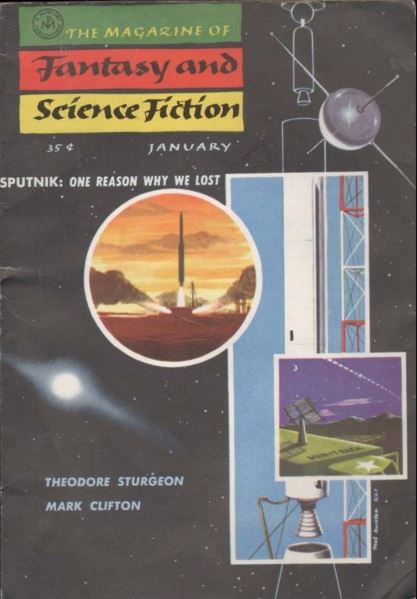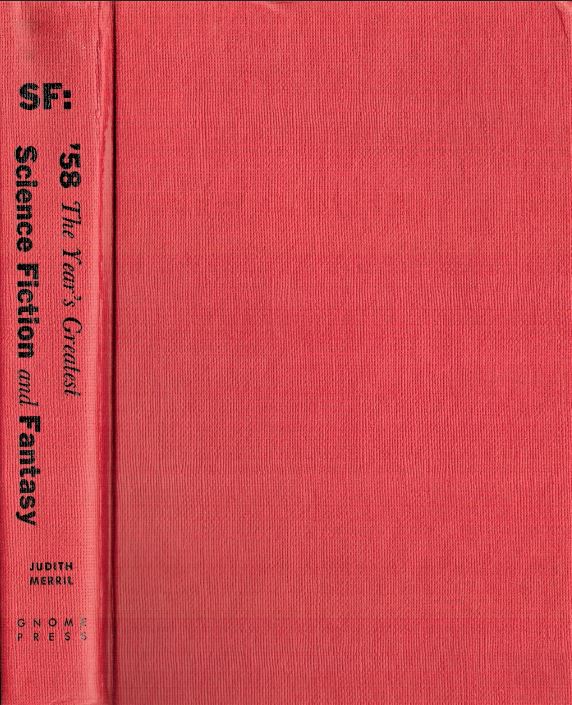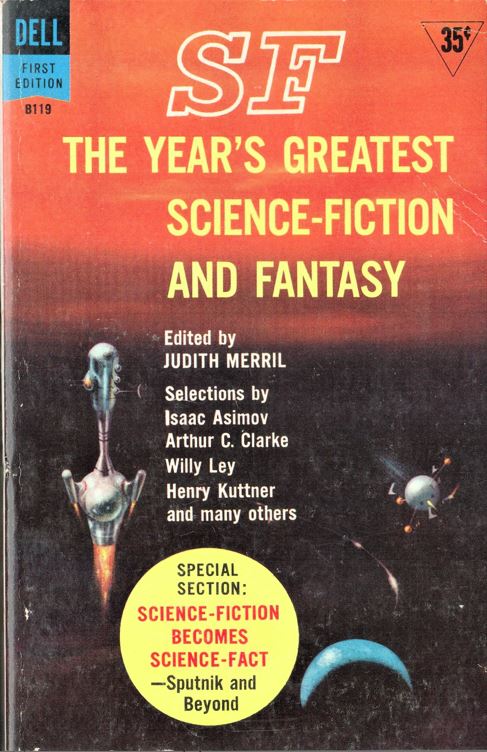Comments
The Henry Kuttner story “Near Miss” is original to this volume, surely unique or nearly so for an entry in a best-of-the-year anthology. Kuttner died on February 4, 1958. Merril calls this Kuttner’s last unpublished story, so its inclusion is a tribute to him. (She presumably meant last written or last unsold story. His last published f&sf story, “A Cross of Centuries,” postdated this volume and appeared in Star Science Fiction Stories 4, edited by Frederik Pohl and released in November 1958.) The introduction to the story hints that it had been written in 1957 rather than earlier, making it at least technically eligible for the volume. No explanation is given for the oddity of its appearing here rather than in a regular science fiction magazine. Doing so would have paid more and offered the likelihood of a future anthology publication and more income, normally a serious matter for f&sf writers in the 1950s. Perhaps because of the oddness of its birth, the story remains completely obscure, never appearing again in any form until a high-priced 2010 Kuttner and Moore tribute collection. The Kuttner name was sometimes used for stories Kuttner wrote by himself, sometimes for collaborations with his wife, C. L. Moore. (See Tomorrow and Tomorrow/The Fairy Chessmen.) It is not known which this might be. Perhaps telling is that Moore never wrote science fiction again after his death, although they had been moving away from the f&sf world in any case. The couple had crossed coasts back to Los Angeles to pursue degrees and teach at USC while making plans to write for the infinitely more lucrative tv and movie business. In addition, they returned to writing mysteries, also far better paying in the 1950s, with the last of four novels in their Michael Gray series not published until after Kuttner’s sudden death. Kuttner is usually given as sole author of these novels but Moore never wrote another mystery, either. His death ended two fabled careers.
Sputnik was the science event of the 1950s. Merril added a section of somewhat random nonfiction presumably because people were still talking about nothing else. Her section title, “From Science Fiction to Science Fact,” was unexpectedly prescient. Unlike the post-WWII era that boosted science fiction in both respectability and sales, the post-Sputnik era comprised perhaps the worst few years in the genre’s modern history. By 1960 a plaintive questionnaire titled Who Killed Science Fiction? won the Hugo Award for Best Fanzine. The field would stage a dramatic rebound with the New Wave movement of the late 1960s, but that was many years too late for Greenberg to have a chance of survival.
Gnome Notes
The bibliographic confusion about the titles in this series continues unabated. The front cover reads SF 58, the jacket spine has it as SF:58, the front and rear flaps give us SF ’58, and the board’s spine, and the title and half title pages all agree on SF: ’58. The last it shall be. The flaps additionally put a hyphen in Science-Fiction that is not found inside, and will be ignored.
CURREY repeats: “Note: Dell and Gnome Press editions published simultaneously.” Dell First Edition B119 claims a June 1958 first printing on the copyright page. The anthology is listed in the Catalog of Copyright Entries under Dell rather than Gnome and with a registration date of July 15, 1958. The Gnome date of issue is unknown. Despite the room for ambiguity, I’m continuing to assume that the paperback is the true first edition. Dell adjusted the print run back up to 153,000 but that still wasn’t enough. A second printing of 26,500 was released in November 1958.
Reviews
S. E. Cotts, Fantastic, January 1959
One could rest well content just by reading such an excellent volume of stories, but in addition, this book offers so many other features.
Floyd C. Gale, Galaxy Science Fiction, December 1959
The real trouble is that her literary tastebuds are too few, too far apart, and too overdeveloped, so that sharing an anthologized meal with her causes gagging, about halfway through, to those who don’t share her affliction….
Using a large section of her book for Sputnik articles is surely one of the great editorial blunders of our time.
Contents and Original Publication
• Judith Merril, “Introduction” (original to this volume).
• story introductions, unsigned, presumably by Judith Merril (original to this volume).
• Brian Aldiss, “Let’s Be Frank” (Science Fantasy, June 1957).
• George Langelaan, “The Fly” (Playboy, June 1957).
• Isaac Asimov, “Let’s Get Together” (The Magazine of Fantasy & Science Fiction, February 1957).
• George Byram, “The Wonder Horse” (The Atlantic Monthly, August 1957).
• Theodore R. Cogswell, “You Know Willie” (The Magazine of Fantasy & Science Fiction, May 1957).
• Henry Kuttner, “Near Miss” (original to this volume).
• Rog Phillips, “Game Preserve” (If, October 1957).
• Avram Davidson, “Now Let Us Sleep” (Venture Science Fiction, September 1957).
• Zenna Henderson, “Wilderness” (The Magazine of Fantasy and Science Fiction, January 1957).
• Eugène Ionesco, “Flying High” (Mademoiselle, October 1957).
• Algis Budrys, “The Edge of the Sea” (Venture Science Fiction, March 1958).
From Science Fiction to Science Fact: Sputnik and Beyond
• Judith Merril, “How Near Is the Moon?” (original to this volume).
• Arthur C. Clarke, “Transition—From Fantasy to Science” (original to this volume).
• G. Harry Stine, “Sputnik: One Reason Why We Lost” (The Magazine of Fantasy & Science Fiction, January 1958).
• Dennis Driscoll, “Going Up!” (Boys’ Life, May 1957).
• Willy Ley, “Where Do We Go from Here?” (original to this volume).
• Anthony Boucher, “Science Fiction Still Leads Science Fact” (The New York Times Magazine, December 1, 1957).
• Judith Merril, “A Summary” (original to this volume).
• Judith Merril, “Honorable Mention” (original to this volume).
Bibliographic Information
SF: ’58 The Year’s Greatest Science-Fiction and Fantasy, Edited by Judith Merril, 1958, copyright registration 15Jul58, Library of Congress Catalog Card Number 56-8938, title #71, back panel #38, 255 pages, $3.50. 4000 copies printed, 1263 remaindered. Hardback. Jacket design by W. I. Van der Poel, Jr. “First printing” stated on copyright page. Designed by Western Printing & Lithographing Company. Printed by Noble Offset Co., New York. Bound by H. Wolff, New York. Manufactured in the U.S.A. Back cover: 35 titles. Gnome Press address given as P.O. Box 161, Hicksville, N.Y.
Variants, in probable priority
1) (CURREY A) Red boards, spine lettered in black.
2) (CURREY B) Red cloth, spine lettered in black.
True first edition
Dell First Edition, B119, (New York: Dell Publishing Co), First printing – July 1958.
Images









